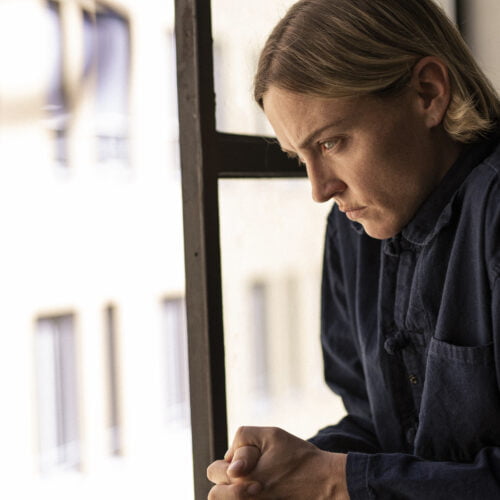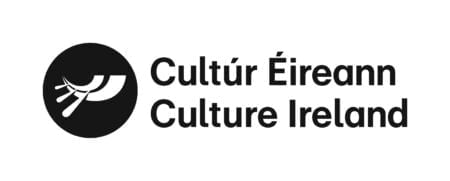Northern Ireland's Oona Doherty returns to Dansens Hus with 12 dancers, bold movement, spoken word poetry, politics and eclectic music from British indie artist Jamie xx to Sergei Rachmaninov.
TicketsVenue
Duration
60 minutes
5 Oct
19:00
6 Oct
19:00
7 Oct
15:00
Northern Ireland's Oona Doherty is a rapidly rising star on the international dance scene. She is based in Belfast but tours internationally with several of her performances. Navy blue is her fourth, and so far largest, work for 12 dancers. Doherty's choreographic style balances on a quivering line of desperation, political rage, despair - but also hope. Navy blue is no exception.
Surrounded by a dark night, we meet 12 dancers - all with a creeping sense of dread, anxiety and destructiveness in mind and body. Navy Blue is fuelled by a brash, tongue-in-cheek dance, spoken word poetry, political dogma and eclectic music. It starts in the light and dramatic Rachmaninov. But as the show progresses, life becomes unravelled, darkness falls and the music changes to British indie musician Jamie xxs pulsating sound carpets.
Navy Blue premiered at Kampnagel in Hamburg last summer and has since been performed at Sadler's Wells in London and the Théâtre National de Chaillot in Paris, among others.

Oona Doherty
Oona Doherty is a dancer and choreographer based in Northern Ireland. She trained at the London School of Contemporary Dance, the University of Ulster and LABAN London where she received both BA and PhD awards in contemporary dance studies.
Doherty has been on stage since 2010, collaborating with companies such as TRASH (NL) Abbattoir Ferme (BE) and Veronika Riz (IT). She now creates her own work which has achieved great success both nationally and internationally.
Doherty's pioneering choreography has earned her numerous awards and prestigious opportunities both in Ireland and abroad. Her solo work Hope Hunt and the Ascension into Lazarus (2015) won Best Performance at the 2016 Dublin Tigre Fringe Award and the Total Theatre Award for Dance at the 2017 Edinburgh Festival.
Her first group piece Hard to Be Soft - A Belfast Prayer was voted best dance performance of 2019 by The Guardian.
In 2019 she created Lady Magma: The Birth of a Cult and in 2021 she had her first collaboration with (La) Horde, a collective at the Ballet Nationale de Marseille (FR). In 2021 she was awarded the Silver Lion at the Venice Biennale Danza 2021.

Oona Doherty on Navy Blue
How can I develop unison dread on stage? Dance form as a problematic symbol of freedom? Unison as a type of micro communism. individualism as a disease? Using classical dance form and theatre norms as the playing field of a violent act.
Can you tell us a bit about the background and what led you to create Navy Blue?
It was 2019 and I was in Aix-de-Provence with Lady Magma. And I was exhausted and stressed. I told my 'magmas' that I couldn't cope with all the work and touring. I needed a break.
Cut to the Balett National de Marsielle. I feel afraid of a ballet company in a large institution. Old wounds are torn open.
I went to a flea market and bought a navy blue worker's jacket because it was hipster. I flew home. I felt successful and lonely and sad. I thought the world was crazy.
The jacket was made for workers. The history of the blue colour is full of trauma, hierarchies and wars over money.
Suddenly it was lockdown. Pregnant. I started thinking differently about my life. About dance. I talked to Ruth Little. She told me to look at Anne Hamilton's work Indigo Blue (1991).
I started trying to look at my own preconceptions: constructed in racism and cast in a capitalist world... being a mum.
What the hell.
So then I had the blues.
So then I made navy.
What is your creative process when creating a choreographic work, are there any specific techniques or stylistic choices that are important to you during your process?
I desire - and always strive for - a sincerity in the dancer I work with, and for me that is more important than aesthetics. But, I'm also sure that there are certain aesthetic choices about what I like that are built into me. I don't know if I've made enough works yet to be able to distinguish the "I" from the "it"/"work".
A destruction, A death of a form, A re-birth.We arch up into the Galactic black of deep space. Scattered with shooting stars, with bodies tearing through the night sky a deep acrylic blue.
What social and emotional themes did you want to explore when creating the choreography for Navy Blue?
In a unison dance there is always a subtle compromise, or sacrifice, for the individual dancer. Individuality, flow, timing and structure become subordinate to the common good of the work. The unison. This reminds me of certain elements of communism. Or socialism. Strikes and demonstrations. And at the same time: strictly coordinated dance also reminds me of fascist marches and displays. Some ballet companies cut their dancers' hair in the same style, yet it is the opening dancer who steps forward alone and bows to the audience, even though everyone on stage is sweating equally.
There is something political about a group moving together. And on a dramaturgical level, I wondered where the power is? If the power is not within the group or through the group's movements, where is it? Within the space or the sound. And then it can be the oppression.
What if a "ballet company" did not make an effort to create the illusion of anti-gravity, romance or joy? What if it is the effort, toil and labour that we are actually witnessing?
And this made me start thinking from the audience's perspective. Why are we watching the dancers work and sometimes struggle with what they are doing?
This is a bow to dance, this is a questioning of what to do next.
Is there anything important for the audience to reflect on when they meet Navy Blue?
I want my blues to feel love for each other. I want them to feel terribly new in the moment. I want them to experience that they feel something, but that it is up to the history of their nervous system what they feel, and what sensations it gives them. I want them to feel something, follow their gut and trust it.
In a interview in The Guardian you said that "music is the greatest art form". In Navy Blue, the audience will hear music from both Rachmaninov and Jamie XX. When you create a dance performance, what comes first: the music or the movements?
I think it's the music, but it might not even be the same music that ends up in the performance and I would never improvise movements without music.

Brutally beautiful as raised fists wither away
An ode to the cruelty and pointlessness of life.
gritty realism, visceral movement style and fearless attitude to confronting controversial topics
It is strong, sensitive and beautiful
Choreography
Oona Doherty
Dancers
Amancio Gonzalez Miñon, Andréa Moufounda, Arno Brys, Kinda Gozo, Hilde Ingeborg Sandvold, Joseph Simon, Mathilde Roussin, Ryan O'Neill, Sati Veyrunes, Thibaut Eiferman, Tomer Pistiner, Zoé Lecorgne, Magdalena Öttl
Music co-operation
Jamie xx
Collaborative writing
Bush Moukarzel
Video projections
Nadir Bouassria
Lighting design and technology
John Gunning
Stage manager
Lisa Marie Barry
Costume
Oona Doherty, Lisa Marie Barry
Management and production
Gabrielle Veyssiere
Production and administration
Jenny Suarez and Virginie Reymond
Produced by
OD Works
Co-production
Kampnagel International Summer Festival (DE), Sadler's Wells (UK), Théâtre National de Chaillot (FR), La Biennale di Venezia (IT), Maison de la Danse (FR), Belfast International Arts Festival (UK), The Shed (USA) and Big Pulse Dance Alliance (coproduced by Dance Umbrella (UK), Dublin Dance Festival (IR), Torinodanza Festival (IT) and Julidans (NL)
Co-funded by
The Creative Europe programme of the European Union
Supported by
Kulturstiftug des Bundes and the support of the Direction régionale des affaires culturelles d'Ile-de-France - Ministère de la culture












